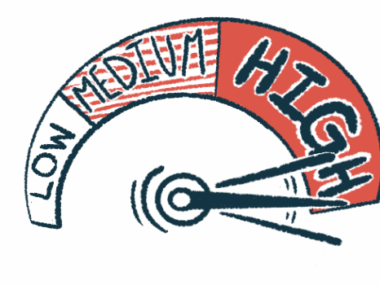Claims Analysis Shows High Comorbidities, Care Costs for Patients
Written by |

People with neuromyelitis optica spectrum disorder (NMOSD) experience a high prevalence of co-existing conditions, or comorbidities, which are associated with much higher healthcare costs, a claims analysis demonstrated.
In particular, pharmacy costs for NMOSD patients with any comorbidity were “significantly higher” than for those with no co-existing conditions: a median of nearly $1,500 annually versus less than $500, the study noted.
The findings underscore the need for effective therapies, particularly for patients with co-occurring autoimmune conditions. They also highlight the importance of better understanding the molecular mechanisms linking NMOSD and other autoimmune diseases, according to researchers.
“Patients with NMOSD experience significant disease burden and cost that are amplified by comorbidities. Effective therapies are needed,” the researchers wrote, adding that “the consequences of autoimmune comorbidities in NMOSD are financially, emotionally and physically profound.”
The study, “Burden and cost of comorbidities in patients with neuromyelitis optica spectrum disorder,” was published in the Journal of Neurological Sciences.
NMOSD has been linked with a greater incidence of other health conditions, from autoimmune diseases such as lupus and Sjögren’s syndrome, to non-autoimmune disorders like diabetes, high blood pressure, and cardiovascular disease.
However, studies exploring the incidence and prevalence of these comorbid or co-existing conditions, and the additional associated costs, are limited.
To address that, scientists based at Genentech (a Roche subsidiary) — the company that markets the approved NMOSD therapy Enspryng (satralizumab) in the U.S. — examined claims data from NMOSD included in the IBM MarketScan Commercial and Medicare Supplemental Databases from 2014 to 2018.
A total of 162 patients were included in the claims analysis. As controls, a group of 810 non-NMOSD patients, matched to NMOSD patients based on age, sex, geographic location, insurance type, and continuous enrollment period, also was examined. The participants’ ages ranged from 33 to 58 years, with a median age of 45, and the majority (73.5%) were women.
Overall, co-existing medical conditions were significantly more frequent in the NMOSD group (66.7%) than in non-NMOSD patients (41.5%). The most common were high blood pressure and cardiovascular disease.
The Charlson Comorbidity Index (CCI) — a method to predict 10-year survival in patients with multiple comorbidities — was assessed during an initial six-month period before the NMOSD diagnosis (baseline) and after 12 months or one year of follow-up. NMOSD patients had significantly higher mean CCI scores than matched controls, both at baseline (0.96 vs. 0.34) and at follow-up (1.62 vs. 0.52).
The cost of medicines was significantly higher for people with NMOSD with any comorbidity compared with NMOSD patients without a comorbidity — a median of $1,489.75 versus $422.04. There also were higher inpatient, outpatient, and total costs trends with NMOSD, the claims analysis showed.
These differences were even greater for NMOSD patients who had co-existing autoimmune conditions, compared with those with NMOSD who did not have autoimmune diseases. These costs were $5,210.73 for those with autoimmune conditions compared with $885.77 for patients without autoimmune disorders. The total healthcare resource costs per patient were significantly higher as well, at $68,386.48 vs. $23,905.42.
A significantly higher number of autoimmune diseases occurred in patients with NMOSD than those without (19.1% vs 4.9%), with 4.9% of these individuals having more than one additional autoimmune disease versus less than 1%, specifically 0.6%, of patients without NMOSD.
The most common autoimmune conditions in NMOSD patients were systemic lupus erythematosus (5.6%), rheumatoid arthritis (4.3%), Sjögren’s syndrome (3.1%), and autoimmune encephalitis, or brain inflammation (2.5%), which were all more common in patients than in controls.
“These results suggest that autoimmune comorbidities may associate with NMOSD and point to similar underlying mechanisms between related autoimmune diseases,” the scientists wrote.
Finally, the team compared non-autoimmune comorbidities in individuals with and without NMOSD. A significantly higher proportion of NMOSD patients had a non-autoimmune disease (61.7% vs. 40.5% for controls), and there also were more patients who had more than one non-autoimmune disease comorbidity (37.0% vs. 21.9%).
The most common comorbidities in NMOSD patients were high blood pressure (30.9%), cardiovascular disease (27.2%), and diabetes (16.1%), and these patients had significantly higher rates of cardiovascular disease, diabetes, high blood sugar, and liver disease than those without NMOSD.
“The association of these diseases with NMOSD may suggest shared predisposing genetic or environmental factors or be a consequence of treatment: corticosteroids used to suppress inflammation in NMOSD are associated with hyperglycemia and diabetes mellitus, while other immunosuppressants are linked to cardiovascular disease,” the scientists added.
Pharmacy costs were significantly higher for NMOSD patients with a non-autoimmune disease than in those without ($1,489.75 vs. $496.67), as were the total median healthcare resource costs per patient ($36,618.32 vs. $21,643.85), the claims analysis showed. Again, all healthcare resource costs per patient were significantly higher for patients with NMOSD.
Across all analyses, healthcare costs for NMOSD patients, with or without comorbidities, were always significantly higher than for non-NMOSD patients with similar comorbidities. This suggests that NMOSD per se poses a significant burden to patients, and that this burden exponentially increases with the presence of additional conditions, particularly autoimmune ones.
“Even with more accurate diagnoses and improved recognition of the disease, patients with NMOSD still incur significant burdens associated with cost of disease across healthcare resources compared with matched non-NMOSD controls,” the researchers wrote.
“Understanding the mechanisms of disease between NMOSD and other autoimmune diseases may improve treatment decisions and therapeutic options,” they concluded.






